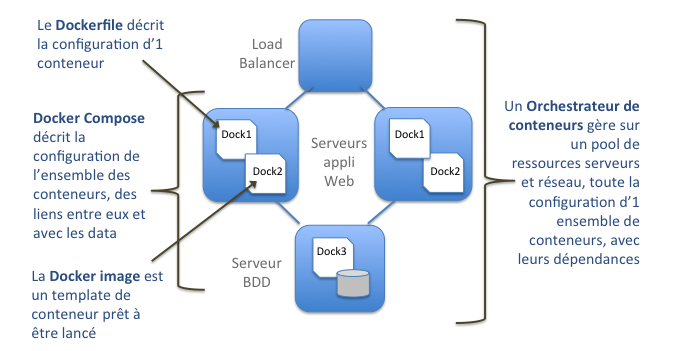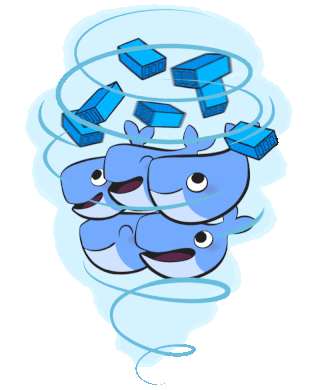Glossaire Docker¶
- Agile Software Development
- A set of concepts, practices and principles for the development of software under which both requirements and the software that meets them evolve during the development life-cycle by processes of collaboration, as opposed to being defined at milestones within it
- Containers
- Running instances of Docker images — containers run the actual applications. A container includes an application and all of its dependencies. It shares the kernel with other containers, and runs as an isolated process in user space on the host OS. You created a container using docker run which you did using the alpine image that you downloaded. A list of running containers can be seen using the docker ps command.
- Docker
- Définition 1 (anglais)
Docker allows us to easily create clean, pre-installed images of our application in an isolated state, like a binary application build, rather than having to worry about virtual environments and system packages of whatever server we are deploying to. This build can then be tested and deployed as if it was an isolated artifact in and of itself.
- Définition 2
With Docker, you can run your Django project on an Ubuntu server in a container on your laptop, and because Docker is available for Mac, Linux, and Windows, your choice of operating system really comes down to preference. When it comes time to push your code to a staging or production server, you can be sure it’ll run exactly the same as it did on your laptop, because you can configure a Dockerfileto exactly match these environments.
- Docker daemon
- The background service running on the host that manages building, running and distributing Docker containers.
- Docker client
- The command line tool that allows the user to interact with the Docker daemon.
- docker-compose.yml
- Definition 1 (français)
- Le docker compose est un fichier de configuration de l’ensemble des Dockers que vous souhaitez déployer pour votre application, il sert à les déployer et à gérer les liens entre les conteneurs ainsi que les volumes de data.
- Definition 2 (anglais)
The file where you can set up your database, automatically start your server when you start your container, and cool stuff like that.
Source: https://www.revsys.com/tidbits/brief-intro-docker-djangonauts/
- Définition 3 (anglais)
Docker Compose lets you run more than one container in a Docker application. It’s especially useful if you want to have a database, like Postgres, running in a container alongside your web app. (Docker’s overview of Compose is helpful.) Compose allows you to define several services that will make up your app and run them all together.
Source: https://www.revsys.com/tidbits/brief-intro-docker-djangonauts/
- Dockerfile
- Definition 1 (français)
- C’est le fichier texte qui décrit la configuration de votre docker, en général , on part d’une image standard et on ajoute les éléments propres à la configuration de l’application que l’on veut déployer ; une fois le Dockerfile finalisé, on build le conteneur.
- Definition 2 (anglais)
- The name of the file that contains the instructions for setting up your image. Source: https://www.revsys.com/tidbits/brief-intro-docker-djangonauts/
- Docker image
- Definition 1 (français)
C’est l’élément de base d’un docker, on utilise une Docker image à deux stades :
- Au départ, on va chercher une image de base standard pour l’applicatif choisi (Nginx, Php, Redis), le plus souvent dans un repository public, on complète ensuite cette image standard des éléments de configuration de votre application, vous pouvez ensuite enregistrer la nouvelle image dans un repository public, ou privé,
- Definition 2 (anglais)
The file system and configuration of our application which are used to create containers. To find out more about a Docker image, run:
docker inspect alpine
In the demo above, you used the docker pull command to download the alpine image. When you executed the command docker run hello-world, it also did a docker pull behind the scenes to download the hello-world image.
- Definition 3 (anglais)
A lightweight, stand-alone, executable package that includes everything needed to run a piece of software. You will set up a specific image for each project you work on that will tell Docker which packages your project needs, where your code lives, etc.
Source: https://www.revsys.com/tidbits/brief-intro-docker-djangonauts/
- Docker Store
- A registry of Docker images, where you can find trusted and enterprise ready containers, plugins, and Docker editions. You’ll be using this later in this tutorial.
- hyperviseur
- Hyperviseur
- En informatique, un hyperviseur est une plate-forme de virtualisation qui permet à plusieurs systèmes d’exploitation de travailler sur une même machine physique en même temps.
- Hyper-V
Microsoft Hyper-V, codenamed Viridian and formerly known as Windows Server Virtualization, is a native hypervisor; it can create virtual machines on x86-64 systems running Windows.
Hyper-V, également connu sous le nom de Windows Server Virtualisation, est un système de virtualisation basé sur un hyperviseur 64 bits de la version de Windows Server 2008.
- Orchestrateur de conteneurs
L’orchestrateur est un peu au conteneur ce que vSphere/vCenter est à VMware pour des VMs, c’est le logiciel de gestion de l’ensemble des conteneurs sur un pool de ressources serveurs, avec davantage de fonctionnalités que vSphere/vCenter. C’est en quelque sorte un PaaS pour les conteneurs

Un orchestrateur gère un pool de ressources serveurs et réseau .. seealso:: https://actu.alfa-safety.fr/devops/docker-en-production/
- reverse proxy
- proxy inverse
Un proxy inverse (reverse proxy) est un type de serveur, habituellement placé en frontal de serveurs web. Contrairement au serveur proxy qui permet à un utilisateur d’accéder au réseau Internet, le proxy inverse permet à un utilisateur d’Internet d’accéder à des serveurs internes, une des applications courantes du proxy inverse est la répartition de charge (load-balancing).
Le proxy inverse est installé du côté des serveurs Internet. L’utilisateur du Web passe par son intermédiaire pour accéder aux applications de serveurs internes. Le proxy inverse est parfois appelé substitut (surrogate)
- Essaim
- Swarm
- swarm
- Swarm
A swarm is a cluster of one or more Docker Engines running in swarm mode. En français swarm est un essaim

Un essaim de docker engines
- Virtual machine
Have you ever seen someone boot up Windows on a Mac ? That process of running one complete OS on top of another OS called running a virtual machine.